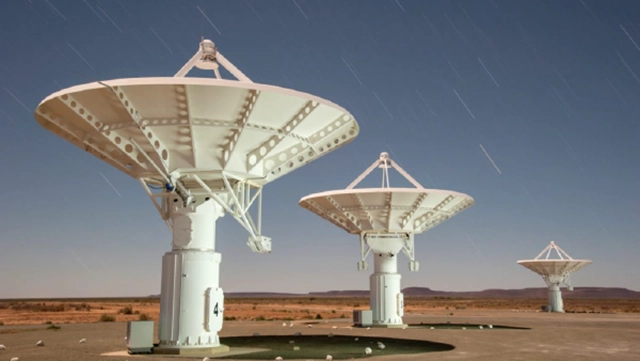
By Siviwe Mxuma
In a ground-breaking acknowledgement of excellence, the Centre for Radio Astronomy Techniques and Technologies (RATT) has been awarded the highly-coveted NRF Science Team Award for 2023.
Since its establishment in 2012, RATT has emerged as the global vanguard in techniques and observational radio astronomy, playing an instrumental role in advancing our understanding of the universe. This award recognises the team's unparalleled contributions to the field and their profound impact on the realms of science, technology, and cosmology.
RATT's journey began with a focused mission: to develop cutting-edge algorithms and software to enhance radio astronomy techniques. Over the years, their scope has expanded exponentially, branching into fundamental astronomy, cosmology, and astrophysics. This evolution was marked by a synergy between advanced data processing and frontiers of scientific exploration, which has propelled RATT to the forefront of global innovation.
The brainchild of RATT's first director, Prof Justin Jonas, also the Chief Technologist of the South African Radio Astronomy Observatory (SARAO), the Centre played a pivotal role in designing and developing the MeerKAT radio telescope. This remarkable instrument now stands as the premier radio telescope in its wavelength regime and across the Southern Hemisphere. RATT's contributions were not confined to MeerKAT's hardware; they were instrumental in crafting the techniques and algorithms that facilitate MeerKAT's ground-breaking research endeavours. The marriage of innovative algorithms and transformative science has made RATT's approach unparalleled, not only in South Africa, but around the world.
Over the years, RATT's dedication to knowledge dissemination has resulted in training over 40 postgraduate students and nurturing the growth of 15 postdoctoral fellows. This commitment to education and fostering the next generation of radio astronomers underscores RATT's enduring impact on the field.
RATT's international recognition extends beyond its prolific research outputs in esteemed journals. Dr Knowles, Dr Ramatsoku, Dr Kuja, Prof. Bernardi, and Prof. Smirnov exemplify RATT's scholarly excellence with an impressive collection of papers, citations, invited commentaries, and colloquia.
The SARAO Human Capital Development (HCD) programme has been a major contributor to RATT's success. The HCD programme established the SARAO Chairs initiative, which allowed Rhodes 老虎机游戏_pt老虎机-平台*官网 to attract Prof Smirnov, and funded the majority of RATT's postdocs and graduate students through the years. RATT's younger generation of researchers are all alumni of the HCD programme.
The laurels continue accumulating as the MeerKAT telescope team, which owes its existence to SARAO, was honoured by the Royal Astronomical Society with the prestigious 2023 Group Achievement Award. While RATT's fingerprints were not directly on MeerKAT's conception, their contribution to its scientific prowess is undeniable. The iconic image of the Galactic Centre unveiled during MeerKAT's inauguration, created by RATT's visiting professor Ian Heywood, stands as a testament to RATT's pioneering techniques and the software innovations developed by their brilliant PhD students.
RATT's influence transcends national boundaries. While student funding adheres to NRF regulations, attracting South African and Square Kilometre Array (SKA) Africa partner countries, RATT's postdoctoral fellows hail from across the globe, creating a richly diverse and accomplished research collective. The team's impact reverberates globally through international collaborations and initiatives such as the "3GC" workshops and their active role in the Astronomical Data Analysis Software and Systems (ADASS) conference.
In light of these monumental achievements, the NRF Science Team Award is a well-deserved recognition of RATT's indomitable spirit, innovative prowess, and relentless pursuit of cosmic enlightenment. As the team continues to push the boundaries of radio astronomy, their legacy inspires the world to look beyond and explore the mysteries of the universe.
According to NRF, this award is made in recognition of the contributions, creativity, and achievements of a science team towards extending the boundaries of scientific research in Africa, producing science outcomes that have positively impacted society, and for the role they played in raising South Africa’s international stature as a world-class research destination. The award includes a research grant of R500 000.00.
Prof Jonas stated, “Radio Astronomy in Africa had its origins at Rhodes 老虎机游戏_pt老虎机-平台*官网, so it is very rewarding that after five decades, RATT has been acknowledged as a world-leading centre in the field. The first radio telescope in Africa was built on the campus in 1958, located behind Prince Alfred House, between the Barratt complex and the Department of Zoology and Entomology. Since then, the Department of Physics and Electronics has gained a reputation for developing instrumentation and techniques for novel radio astronomy experiments, and staff, students, and alumni have contributed significantly to the MeerKAT and SKA telescopes. Under the research leadership of A-rated scientist Prof Oleg Smirnov, RATT has become an international hub for leading researchers, epitomising the Rhodes vision as a global research leader.”
For more information on RATT, see here: https://ratt.center/
